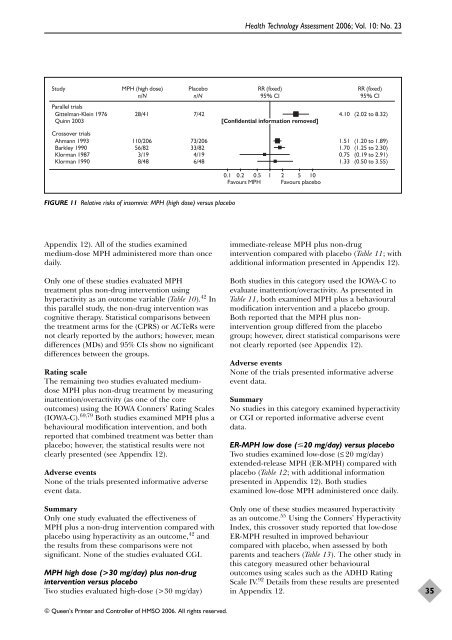A systematic review and economic model of the effectiveness and ...
A systematic review and economic model of the effectiveness and ...
A systematic review and economic model of the effectiveness and ...
Create successful ePaper yourself
Turn your PDF publications into a flip-book with our unique Google optimized e-Paper software.
Study<br />
Parallel trials<br />
Gittelman-Klein 1976<br />
Quinn 2003<br />
Crossover trials<br />
Ahmann 1993<br />
Barkley 1990<br />
Klorman 1987<br />
Klorman 1990<br />
MPH (high dose)<br />
n/N<br />
28/41<br />
110/206<br />
56/82<br />
3/19<br />
8/48<br />
Placebo<br />
n/N<br />
7/42<br />
73/206<br />
33/82<br />
4/19<br />
6/48<br />
FIGURE 11 Relative risks <strong>of</strong> insomnia: MPH (high dose) versus placebo<br />
Appendix 12). All <strong>of</strong> <strong>the</strong> studies examined<br />
medium-dose MPH administered more than once<br />
daily.<br />
Only one <strong>of</strong> <strong>the</strong>se studies evaluated MPH<br />
treatment plus non-drug intervention using<br />
hyperactivity as an outcome variable (Table 10). 42 In<br />
this parallel study, <strong>the</strong> non-drug intervention was<br />
cognitive <strong>the</strong>rapy. Statistical comparisons between<br />
<strong>the</strong> treatment arms for <strong>the</strong> (CPRS) or ACTeRs were<br />
not clearly reported by <strong>the</strong> authors; however, mean<br />
differences (MDs) <strong>and</strong> 95% CIs show no significant<br />
differences between <strong>the</strong> groups.<br />
Rating scale<br />
The remaining two studies evaluated mediumdose<br />
MPH plus non-drug treatment by measuring<br />
inattention/overactivity (as one <strong>of</strong> <strong>the</strong> core<br />
outcomes) using <strong>the</strong> IOWA Conners’ Rating Scales<br />
(IOWA-C). 69,79 Both studies examined MPH plus a<br />
behavioural modification intervention, <strong>and</strong> both<br />
reported that combined treatment was better than<br />
placebo; however, <strong>the</strong> statistical results were not<br />
clearly presented (see Appendix 12).<br />
Adverse events<br />
None <strong>of</strong> <strong>the</strong> trials presented informative adverse<br />
event data.<br />
Summary<br />
Only one study evaluated <strong>the</strong> <strong>effectiveness</strong> <strong>of</strong><br />
MPH plus a non-drug intervention compared with<br />
placebo using hyperactivity as an outcome, 42 <strong>and</strong><br />
<strong>the</strong> results from <strong>the</strong>se comparisons were not<br />
significant. None <strong>of</strong> <strong>the</strong> studies evaluated CGI.<br />
MPH high dose (>30 mg/day) plus non-drug<br />
intervention versus placebo<br />
Two studies evaluated high-dose (>30 mg/day)<br />
© Queen’s Printer <strong>and</strong> Controller <strong>of</strong> HMSO 2006. All rights reserved.<br />
Health Technology Assessment 2006; Vol. 10: No. 23<br />
RR (fixed)<br />
95% CI<br />
[Confidential information removed]<br />
0.1 0.2 0.5 1 2 5 10<br />
Favours MPH Favours placebo<br />
4.10<br />
1.51<br />
1.70<br />
0.75<br />
1.33<br />
RR (fixed)<br />
95% CI<br />
(2.02 to 8.32)<br />
(1.20 to 1.89)<br />
(1.25 to 2.30)<br />
(0.19 to 2.91)<br />
(0.50 to 3.55)<br />
immediate-release MPH plus non-drug<br />
intervention compared with placebo (Table 11; with<br />
additional information presented in Appendix 12).<br />
Both studies in this category used <strong>the</strong> IOWA-C to<br />
evaluate inattention/overactivity. As presented in<br />
Table 11, both examined MPH plus a behavioural<br />
modification intervention <strong>and</strong> a placebo group.<br />
Both reported that <strong>the</strong> MPH plus nonintervention<br />
group differed from <strong>the</strong> placebo<br />
group; however, direct statistical comparisons were<br />
not clearly reported (see Appendix 12).<br />
Adverse events<br />
None <strong>of</strong> <strong>the</strong> trials presented informative adverse<br />
event data.<br />
Summary<br />
No studies in this category examined hyperactivity<br />
or CGI or reported informative adverse event<br />
data.<br />
ER-MPH low dose (20 mg/day) versus placebo<br />
Two studies examined low-dose (≤ 20 mg/day)<br />
extended-release MPH (ER-MPH) compared with<br />
placebo (Table 12; with additional information<br />
presented in Appendix 12). Both studies<br />
examined low-dose MPH administered once daily.<br />
Only one <strong>of</strong> <strong>the</strong>se studies measured hyperactivity<br />
as an outcome. 55 Using <strong>the</strong> Conners’ Hyperactivity<br />
Index, this crossover study reported that low-dose<br />
ER-MPH resulted in improved behaviour<br />
compared with placebo, when assessed by both<br />
parents <strong>and</strong> teachers (Table 13). The o<strong>the</strong>r study in<br />
this category measured o<strong>the</strong>r behavioural<br />
outcomes using scales such as <strong>the</strong> ADHD Rating<br />
Scale IV. 92 Details from <strong>the</strong>se results are presented<br />
in Appendix 12.<br />
35
















